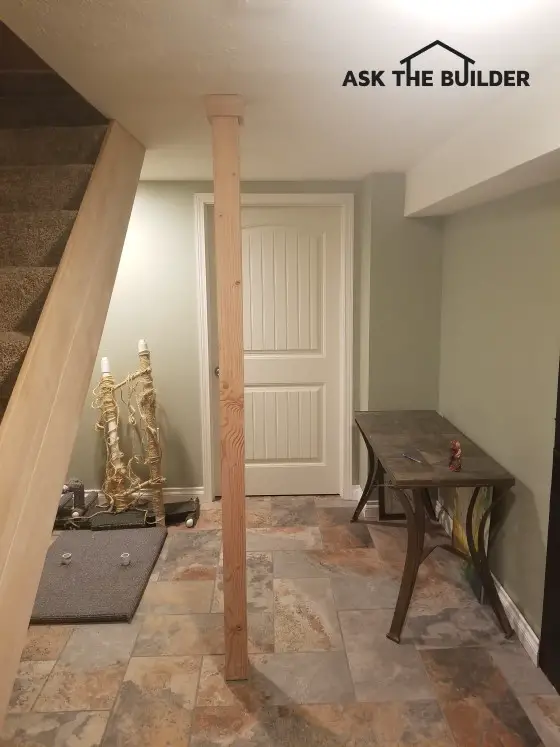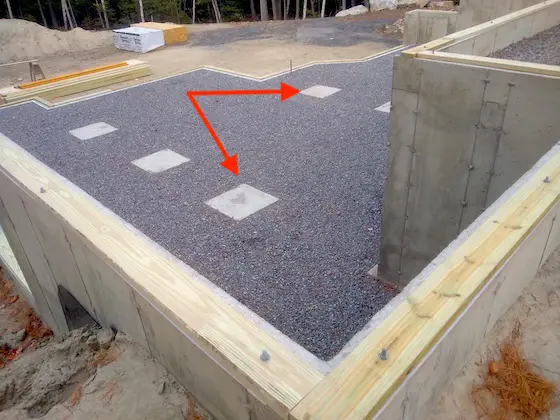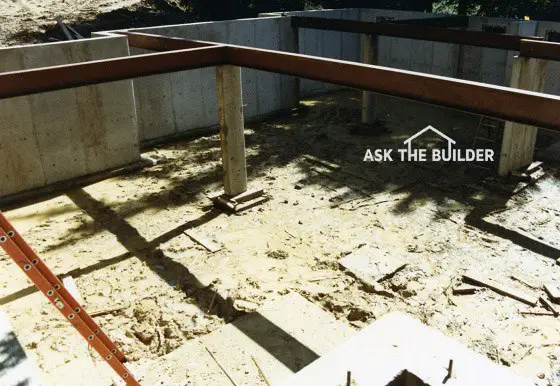Move a Support Post

Move a Support Post | Some support columns are easy to move. Others are so hard it makes your brain hurt to think all that needs to be done. Copyright 2020 Tim Carter
QUESTION: Yo, Tim. I have this load-bearing post right in front of my laundry room door. What can a person do to remove or relocate it to a more convenient location? Is this something that a reasonably handy homeowner with a decent array of tools can do by himself? Can you share all that’s involved? Do you have a clue how this column ended up in such an inconvenient location? Is there a way to have fewer support columns in basements and crawlspaces? Andrew Van W., Spokane, WA
I sure hope you’re able to see the photo (above) that Andrew sent to me. Oh my! It’s a great example of how not to think ahead. Not knowing all the facts, I speculate the architect or draftsperson had no idea that the basement might be finished at a later date.
Related Links:
Support Post and Beam Construction Tips
If Andrew could jump into a time machine, I’m quite sure he would have tried to put the staircase so the side of the one stringer was just an inch away from the side of the column, or he would have had the structural engineer come up with a different support plan so the column would have been out of the way. It’s even possible to have no support columns at all. Watch this video!
How Do You Install a Support Post?
Let’s discuss how these posts or columns are installed in a typical home and then you’ll start to appreciate what’s involved in moving one. First and foremost, there should be a footing pad at least 2-feet by 2-feet by 8 inches thick under the post or column. This distributes the weight bearing down on the post over a greater area.

The red arrows point to two of the five support post/column footings.
Without this footing, the column could poke into the soil like you might put a toothpick into a juicy watermelon ball or piece of cheese. You don’t want support columns sinking into the soil for goodness sake.
Should a Support Post be Bolted to the Footing?
Many structural engineers require the support post to be bolted to this footing. You can imagine how hard it would be to remove these bolts if the base of the support column is surrounded by poured concrete. Yes, I know you can cut off the column at the floor level, but this might not be possible.
The top of the support column should also be bolted to the beam that rests on top of the post. These bolts are somewhat easier to deal with and removing them is rarely a challenge.
What is the Biggest Issue Moving a Support Post?
The biggest issue is the overall structural design. Assuming the support beam was designed by a structural engineer or an architect with enough experience to know the correct beam size and column spacing, support posts and columns are in precise pre-determined locations. You can’t just remove a column and move it several feet one way or another hoping everything is going to work out.
What About Concentrated Loads?
It’s possible there’s an enormous concentrated load directly above the support column. I had this in the last home I built for my family. I had an interior bearing wall next to my family room that had a header support post that carried the weight of a second-story exterior wall, part of the attic floor, half the weight of a first-floor roof, and a major portion of the main house roof. I can’t begin to think of how many tons of weight are concentrated on this one post!
DIY Support Post Relocation
The truthful answer is, “Yes, a reasonably handy homeowner with a decent array of tools can’t do this job by himself.” I say this knowing there are some very clever, determined, and resourceful homeowners out there. You may be one.
I temper my answer with this caveat, though. The first thing you must do is hire a residential structural engineer. Have this professional visit your home, survey the job, and develop a small written plan for you to follow. Be sure the plan contains the mission-critical steps of how to temporarily re-support the beam while you do the work.
CLICK or TAP HERE to get FREE BIDS from local structural engineers.
How Can I Have Fewer Support Posts?
All of the misery and expense you’re about to suffer through could have been avoided when the house was built. You actually could have had no support columns or fewer of them.
The common steel beam that is often installed in homes and crawlspaces is an 8 x 17 I-beam. This means it’s 8 inches tall and it weighs 17 pounds per lineal foot. In most homes, this beam requires support about every 8 feet.

Residential steel beam - There are quite a few in a home I built in Amberley Village, Ohio. The beams are 10 inches tall and weigh 31 pounds per linear foot. You can span up to 14 feet with these! © 2018 Tim Carter
Do Steel Beams Come in Different Sizes?
Understand that steel i-beams come in many sizes just like shoes, pants, and shirts. A beam weighing more pounds per foot might have allowed for greater column spacing. A taller and heavier beam like the ones I put in my last house would have allowed you to span 14 feet. I installed 10 x 31 I-beams in my last house.
Amazing wooden floor trusses could have been used in the house. These require no support beams beneath them. They just span all the way across the depth of the house. These are in my daughter’s new home. Here are her floor trusses:
Not only do you not need beams under them, but the HVAC man, the plumber, and the electrician are going to be jumping for joy!The trusses make their jobs go faster and you save money in the long run.
Column 1378
One Response to Move a Support Post